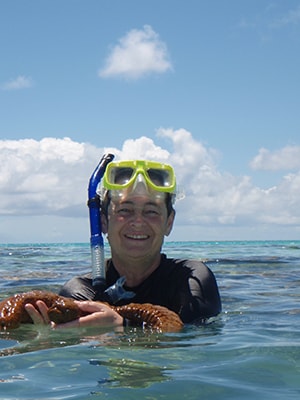Media release from the University of Sydney

Maria Byrne, Professor of Marine Biology at the University of Sydney has researched the unsustainable fishing of sea cucumbers.
Sea cucumber fishing in the Great Barrier Reef Marine Park shows worrying signs of being unsustainable. Many species being targeted are endangered and vulnerable to extinction, as determined by the International Union for Conservation of Nature.
This situation is outlined in a study recently published in the journal Fish and Fisheries by Maria Byrne, Professor of Marine Biology at the University of Sydney and Deputy Director of One Tree Island Research Station, and lead author Dr Hampus Eriksson, post-doctoral researcher at Stockholm University.
“Sea cucumbers play a vital role in reef health and our previous research indicates that they may help reduce the harmful impact of ocean acidification on coral growth. The viability of their numbers may well be crucial to the condition of coral reef ecosystems.”
“The crown-of-thorns starfish is often singled out as responsible for the decline in the barrier reef. This work suggests that overfishing of ecologically important species such as sea cucumbers, may have also contributed to this decline.”
“Until we have a better understanding of levels of sustainable harvest – and the impact this will have on the reef – we recommend introducing precautionary reductions in sea cucumber fishing,” said Professor Byrne. “Extending the current periods when fishing does not occur is also likely to have positive effects on stock recovery.”
Sea cucumbers are harvested around the world to produce the product ‘trepang’ or ‘beche-de-mer’ which is especially popular in China.
In recent years more than 24 sea cucumber fisheries in tropical nations including nearby Samoa, Papua New Guinea and the Solomon Islands have had their fisheries closed due to overfishing.
Over 70 percent of tropical sea cucumber fisheries are now considered depleted, fully exploited or over-exploited.
Overfishing is often blamed on the limited capacity to manage fish stocks in these, often poor, countries.
“Tropical fisheries have followed a predictable path of responding to declines in catches of high-value species by switching to other, often lower value, species which are now also overfished,” said Dr Eriksson.
“We conducted the study on this fishery on the Great Barrier Reef to see what Australia could share with low-income developing countries that lack management capacity.”
Professor Maria Bryne said: “Sadly we found striking similarities with low-income countries. Our analysis of catch reports over a 20 year period (1991 to 2011) showed the same pattern of exploitation with no baseline data to assess change.
In the Great Barrier Reef fishery, the only industrial scale tropical fishery, the high value sea cucumber species, teatfish, has been replaced with lower-value sea cucumber species such as curryfish.
“Pursuing profits by targeting abundant species which sell for less while continuing to fish scarce high-value species is a pathway to their extinction ,” said Dr Eriksson.
“This substantial shortcoming in fishery management is not appropriate for a fishery in the iconic Great Barrier Reef Marine Park, keeping in mind that UNESCO may declare the park as a ‘World Heritage Site in Danger’ and the recent downgrade of reef condition from ‘moderate’ to ‘poor’.”
“While most fisheries in developing countries struggle to monitor catches, in Australia the data exist but are confidential. We have to question whether this confidentiality in catch data – the main source of information for fishery management – is best practice”, said Professor Byrne.
It appears that providing relatively few fishers with exclusive access to a large fishing area through licenses does not safeguard sustainable sea cucumber harvests.
Sorry, the comment form is closed at this time.